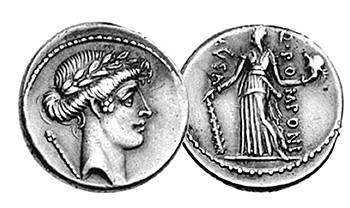
PREV ARTICLE
NEXT ARTICLE
FULL ISSUE
PREV FULL ISSUE
THE MUSES ON ANCIENT COINS
On May 21, 2015 Mike Markowitz published a nice article in CoinWeek on the Muses on ancient coins. Here's an excerpt. -Editor
Calliope The nine Muses were the daughters of Zeus and Mnemosyne, the personification of memory. The Muses represent the inspiration of literature, music and the fine arts. According to one tradition they lived on Mount Helikon (elevation 1,749 meters, or 5,738 ft.) in Boeotia. Another story places their home beside the Pierian spring, at the foot of Mount Olympos (2,919 meters, or 9,570 ft.). Chief among them was Calliope. Calliope (or Kalliope) means “beautiful voice.” She presided over Epic Poetry and Eloquence. Her distinctive symbol was a writing tablet, but on this coin she plays a lyre (a seven-stringed instrument often used to accompany the recitation of poetry). The symbol behind the bust of Apollo on the obverse is a key, for unknown reasons. Melpomene 
Melpomene means “to sing in a choir” or “be melodious.” As the Muse of Tragic Drama, her symbol is a tragic mask. On the reverse of the coin, she holds the mask in one hand and the club of Hercules in the other. She wears a short sword at her belt, symbolizing the (off-stage) violent bloodshed so common in Greek tragedy. The symbol behind Apollo’s neck on the obverse is a scepter, since classic tragedy often dealt with the doings of kings. Terpsichore 
Terpsichore means “delight in dancing” As the Muse of Dance, her symbol is the lyre. On the reverse of the coin, she holds the lyre in her left hand and the plectrum (a large pick used to pluck or strum the strings) in her right. On the obverse, the symbol behind Apollo’s neck is a tortoise, because the sound-box of the earliest Greek lyres was made from the shell of a tortoise. This is a relatively common issue, with 92 examples in the Coinarchives database. Prices in recent sales have ranged from $280 to over $3,600 for an exceptional specimen[2]. Some of these may be erroneous attributions, however; coins with a flower on the obverse and a large, flat-bottomed kithara–rather than a small round-bottomed lyre–may have been intended to honor Erato, the Muse of Lyric (or Erotic) Poetry. Urania 
Urania means “heavenly.” As the Muse of Astronomy her symbol is the celestial globe. On the coin she holds a pointer indicating the globe on a low stand. On one particularly well-preserved example, lines of latitude and longitude can be seen inscribed on the globe[7]. On the obverse, the symbol behind Apollo is an eight-pointed star. To read the complete article, see:
THE BOOK BAZARREWayne Homren, Editor The Numismatic Bibliomania Society is a non-profit organization promoting numismatic literature. See our web site at coinbooks.org. To submit items for publication in The E-Sylum, write to the Editor at this address: whomren@gmail.com To subscribe go to: https://my.binhost.com/lists/listinfo/esylum All Rights Reserved. NBS Home Page Contact the NBS webmaster 
|